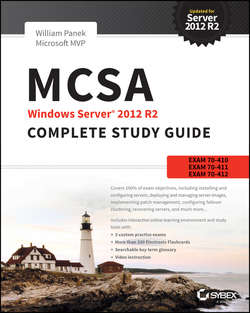Читать книгу MCSA Windows Server 2012 R2 Complete Study Guide - Panek William - Страница 19
На сайте Литреса книга снята с продажи.
Part I
Exam 70-410: Installing and Configuring Windows Server 2012 R2
Chapter 2
Configure Network Services
Introducing DNS Database Zones
ОглавлениеAs mentioned earlier in this chapter, a DNS zone is a portion of the DNS namespace over which a specific DNS server has authority. Within a given DNS zone, there are resource records (RRs) that define the hosts and other types of information that make up the database for the zone. You can choose from several different zone types. Understanding the characteristics of each will help you choose which is right for your organization.
The DNS zones discussed in this book are all Microsoft Windows Server 2012 / 2012 R2 zones. Non-Windows (for example, Unix) systems set up their DNS zones differently.
In the following sections, I will discuss the different zone types and their characteristics.
Understanding Primary Zones
When you’re learning about zone types, things can get a bit confusing. But it’s really not difficult to understand how they work and why you would want to choose one type of zone over the other. Zones are databases that store records. By choosing one zone type over another, you are basically just choosing how the database works and how it will be stored on the server.
The primary zone is responsible for maintaining all of the records for the DNS zone. It contains the primary copy of the DNS database. All record updates occur on the primary zone. You will want to create and add primary zones whenever you create a new DNS domain.
There are two types of primary zones:
■ Primary zone
■ Primary zone with Active Directory Integration (Active Directory DNS)
From this point forward, I refer to a primary zone with Active Directory Integration as an Active Directory DNS. When I use only the term primary zone, Active Directory is not included.
To install DNS as a primary zone, you must first install DNS using the Server Manager MMC. Once DNS is installed and running, you create a new zone and specify it as a primary zone.
The process of installing DNS and its zones will be discussed later in this chapter. In addition, there will be step-by-step exercises to walk you through how to install these components.
Primary zones have advantages and disadvantages. Knowing the characteristics of a primary zone will help you decide when you need the zone and when it fits into your organization.
Local Database
Primary DNS zones get stored locally in a file (with the suffix .dns) on the server. This allows you to store a primary zone on a domain controller or a member server. In addition, by loading DNS onto a member server, you can help a small organization conserve resources. Such an organization may not have the resources to load DNS on an Active Directory domain controller.
Unfortunately, the local database has many disadvantages:
Lack of Fault Tolerance Think of a primary zone as a contact list on your smartphone. All of the contacts in the list are the records in your database. The problem is that, if you lose your phone or the phone breaks, you lose your contact list. Until your phone gets fixed or you swap out your phone card, the contacts are unavailable.
It works the same way with a primary zone. If the server goes down or you lose the hard drive, DNS records on that machine are unreachable. An administrator can install a secondary zone (explained later in the next section), and that provides temporary fault tolerance. Unfortunately, if the primary zone is down for an extended period of time, the secondary server’s information will no longer be valid.
Additional Network Traffic Let’s imagine that you are looking for a contact number for John Smith. John Smith is not listed in your smartphone directory, but he is listed in your partner’s smartphone. You have to contact your partner to get the listing. You cannot directly access your partner’s phone’s contacts.
When a resolver sends a request to DNS to get the TCP/IP address for Jsmith (in this case Jsmith is a computer name) and the DNS server does not have an answer, it does not have the ability to check the other server’s database directly to get an answer. Thus it forwards the request to another DNS. When DNS servers are replicating zone databases with other DNS servers, this causes additional network traffic.
Конец ознакомительного фрагмента. Купить книгу
